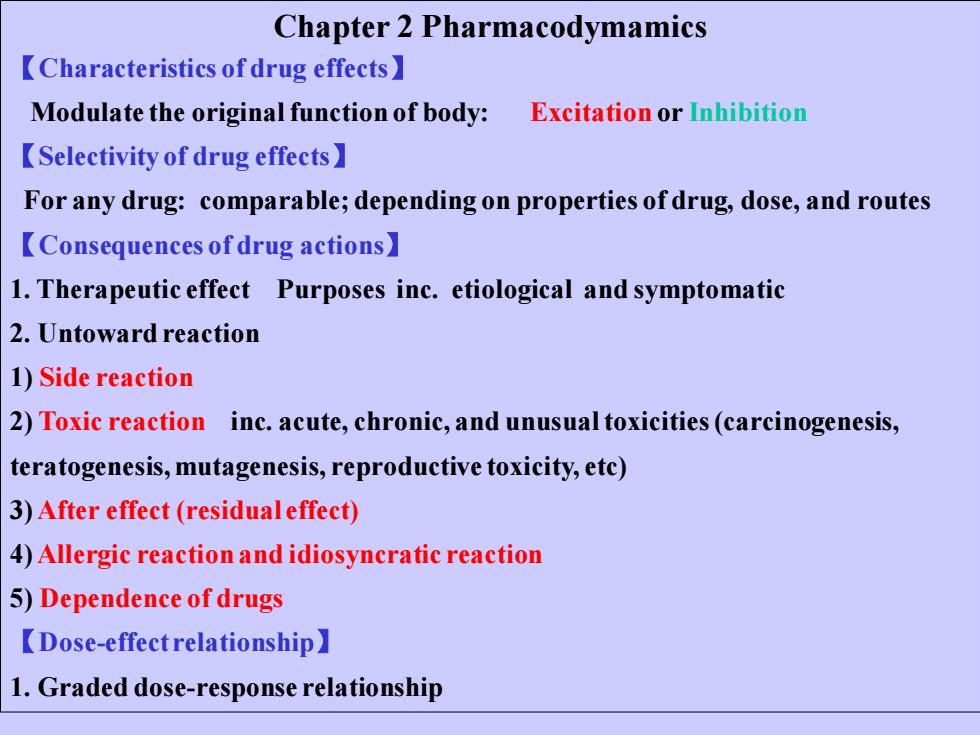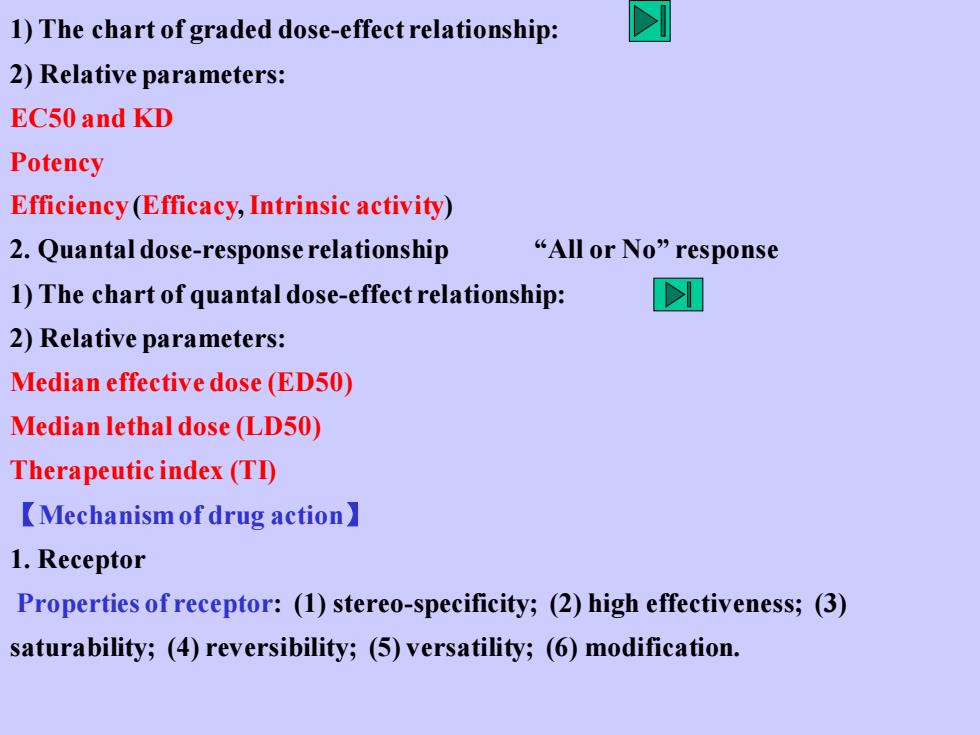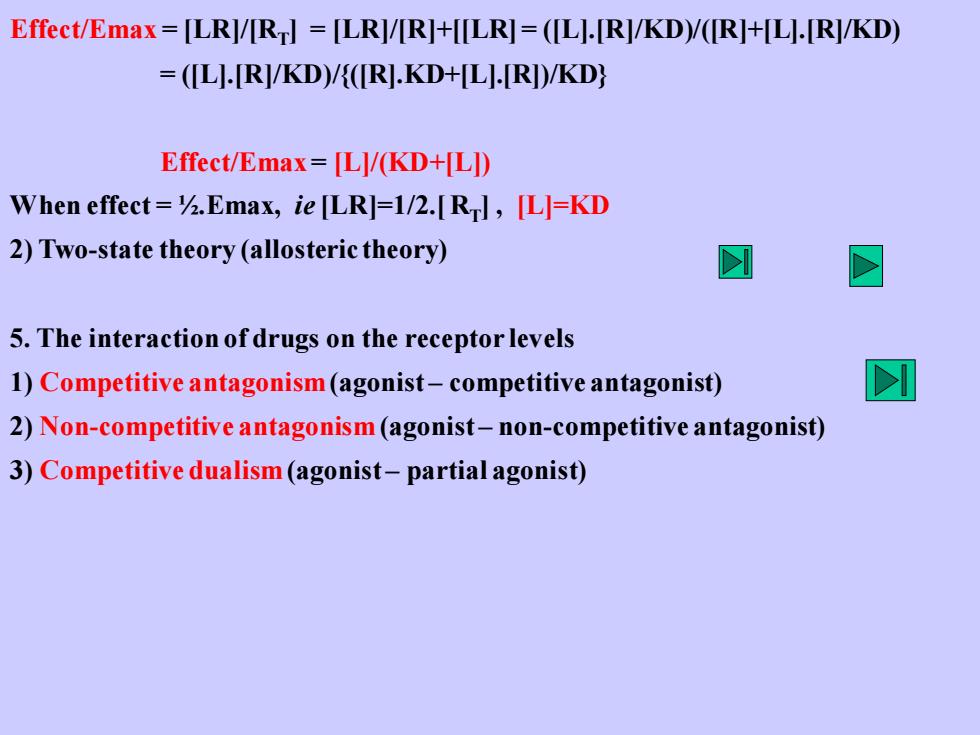
Section 1.Basic Principles of Pharmacology Chapter 1 Introduction 【Definition of Pharmacology】 Relationship between drug and body 【Contents of Pharmacology】 1.Pharmacodynamics drug台body 2.Pharmacokinemics 【Drugs and toxins】 【Diseases from drugs.】 【Relative subjects】 Clinical Pharmacology Drug therapeutics Toxicology
Section 1. Basic Principles of Pharmacology Chapter 1 Introduction 【Definition of Pharmacology】 Relationship between drug and body 【Contents of Pharmacology】 1. Pharmacodynamics drug body 2. Pharmacokinemics 【Drugs and toxins】 【Diseases from drugs】 【Relative subjects】 Clinical Pharmacology Drug therapeutics Toxicology

Chapter 2 Pharmacodymamics 【Characteristics of drug effects】 Modulate the original function of body: Excitation or Inhibition 【Selectivity of drug effects】 For any drug:comparable;depending on properties of drug,dose,and routes 【Consequences of drug actions】 1.Therapeutic effect Purposes inc.etiological and symptomatic 2.Untoward reaction 1)Side reaction 2)Toxic reaction inc.acute,chronic,and unusual toxicities(carcinogenesis, teratogenesis,mutagenesis,reproductive toxicity,etc) 3)After effect(residual effect) 4)Allergic reaction and idiosyncratic reaction 5)Dependence of drugs 【Dose-effect relationship】 1.Graded dose-response relationship
Chapter 2 Pharmacodymamics 【Characteristics of drug effects】 Modulate the original function of body: Excitation or Inhibition 【Selectivity of drug effects】 For any drug: comparable; depending on properties of drug, dose, and routes 【Consequences of drug actions】 1. Therapeutic effect Purposes inc. etiological and symptomatic 2. Untoward reaction 1) Side reaction 2) Toxic reaction inc. acute, chronic, and unusual toxicities (carcinogenesis, teratogenesis, mutagenesis, reproductive toxicity, etc) 3) After effect (residual effect) 4) Allergic reaction and idiosyncratic reaction 5) Dependence of drugs 【Dose-effect relationship】 1. Graded dose-response relationship

1)The chart of graded dose-effect relationship: 2)Relative parameters: EC50 and KD Potency Efficiency(Efficacy,Intrinsic activity) 2.Quantal dose-response relationship “All or No”response 1)The chart of quantal dose-effect relationship: 2)Relative parameters: Median effective dose(ED50) Median lethal dose(LD50) Therapeutic index(TD) 【Mechanism of drug action】 1.Receptor Properties of receptor:(1)stereo-specificity;(2)high effectiveness;(3) saturability;(4)reversibility;(5)versatility;(6)modification
1) The chart of graded dose-effect relationship: 2) Relative parameters: EC50 and KD Potency Efficiency (Efficacy, Intrinsic activity) 2. Quantal dose-response relationship “All or No” response 1) The chart of quantal dose-effect relationship: 2) Relative parameters: Median effective dose (ED50) Median lethal dose (LD50) Therapeutic index (TI) 【Mechanism of drug action】 1. Receptor Properties of receptor: (1) stereo-specificity; (2) high effectiveness; (3) saturability; (4) reversibility; (5) versatility; (6) modification

2.Ligand Binding with special receptor;Standard:high affinity to receptor 1)Full agonist 2)Partial agonist 3)Antagonist 4)Partialinverse agonist 5)Full inverse agonist 3.Evaluation parameters of affinity 1)PD2 2)pA2 4.Drug-Receptor Theory 1)Occupation theory ClarkA.J.(1933) V L R=LR- E V2 Vi=k1-[L][R],v2=k-[LR],k2/k=KD=[L].[RV/[LR],[LR]=[L].[RJ/KD
2. Ligand Binding with special receptor; Standard: high affinity to receptor 1) Full agonist 2) Partial agonist 3) Antagonist 4) Partial inverse agonist 5) Full inverse agonist 3. Evaluation parameters of affinity 1) PD2 2) pA2 4. Drug-Receptor Theory 1) Occupation theory Clark A.J. (1933) V1 L + R = LR - E V2 v1=k1 .[L][R], v2=k2 .[LR], k2 /k1=KD= [L].[R]/[LR], [LR] = [L].[R]/KD

Effect/Emax=[LRJ/[RTl [LR]/[R]+[[LR]=([L].[R]/KD)/([R]+[L].[R]/KD) =([L].[RJ/KD)/([R].KD+[L].[RJ/KD) Effect/Emax=[L]/(KD+[L]) When effect=.Emax,ie [LR]=1/2.[R],[L]=KD 2)Two-state theory (allosteric theory) G 5.The interaction of drugs on the receptor levels 1)Competitive antagonism(agonist-competitive antagonist) I 2)Non-competitive antagonism(agonist-non-competitive antagonist) 3)Competitive dualism(agonist-partial agonist)
Effect/Emax = [LR]/[RT ] = [LR]/[R]+[[LR] = ([L].[R]/KD)/([R]+[L].[R]/KD) = ([L].[R]/KD)/{([R].KD+[L].[R])/KD} Effect/Emax= [L]/(KD+[L]) When effect = ½.Emax, ie [LR]=1/2.[ RT ] , [L]=KD 2) Two-state theory (allosteric theory) 5. The interaction of drugs on the receptor levels 1) Competitive antagonism(agonist – competitive antagonist) 2) Non-competitive antagonism (agonist – non-competitive antagonist) 3) Competitive dualism(agonist – partial agonist)